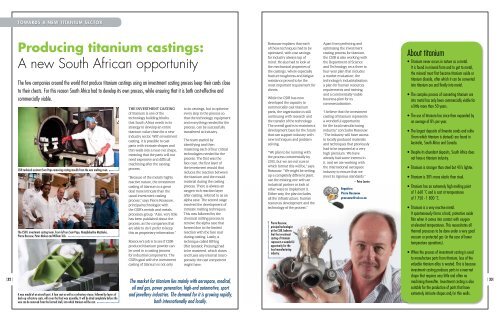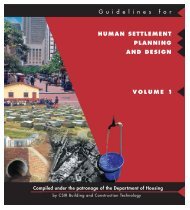Research and development for industry: Advanced ... - CSIR
Research and development for industry: Advanced ... - CSIR
Research and development for industry: Advanced ... - CSIR
Create successful ePaper yourself
Turn your PDF publications into a flip-book with our unique Google optimized e-Paper software.
TOWARDS A NEW TITANIUM SECTOR| 32 |Producing titanium castings:A new South African opportunityThe few companies around the world that produce titanium castings using an investment casting process keep their cards closeto their chests. For this reason South Africa had to develop its own process, while ensuring that it is both cost-effective <strong>and</strong>commercially viable.<strong>CSIR</strong> technical assistant Sam Papo removing casting moulds from the wax melting oven.The <strong>CSIR</strong>’s investment casting team. From left are Sam Papo, Nonjababuiliso Mazibuko,Pierre Rossouw, Peter Malesa <strong>and</strong> William Tefu.A wax mould of an aircraft part. A face coat as well as a refractory stucco, followed by layers ofback-up refractory coats, will cover the final wax assembly. It will be dried completely be<strong>for</strong>e thewax can be removed from the <strong>for</strong>med shell, into which titanium will be cast.The investment castingof titanium is one of thetechnology building blocksthat South Africa needs in itsstrategy to develop an entiretitanium value chain <strong>for</strong> a new<strong>industry</strong> sector. With investmentcasting, it is possible to castparts with intricate shapes <strong>and</strong>thin walls into a near-net shape,meaning that the parts will notneed expensive <strong>and</strong> difficultmachining after the castingprocess.“Because of the metal’s highlyreactive nature, the investmentcasting of titanium is a greatdeal more intricate than theusual investment castingprocess,” says Pierre Rossouw,principal technologist withthe <strong>CSIR</strong>’s metals <strong>and</strong> metalsprocesses group. “Also, very littlehas been published about theprocess, as the companies thatare able to do it prefer to keepthis as proprietary in<strong>for</strong>mation.”Rossouw’s job is to see if <strong>CSIR</strong>producedtitanium powder canbe used in a casting process<strong>for</strong> industrial components. The<strong>CSIR</strong>’s goal with the investmentcasting of titanium is not onlyto do castings, but to optimiseevery step in the process sothat the technology, equipment<strong>and</strong> everything needed <strong>for</strong> theprocess, can be successfullytransferred to <strong>industry</strong>.The team started byidentifying <strong>and</strong> thenmastering each of four criticaltechnologies needed <strong>for</strong> theprocess. The first was theface coat, the first layer ofthe investment mould thatreduces the reaction betweenthe titanium <strong>and</strong> the mouldmaterial during the castingprocess. There is always anoxygen-rich reaction layerafter casting, referred to as analpha case. The second stageinvolved the <strong>development</strong> ofintricate melting techniques.This was followed by thechemical milling process toremove the alpha case that<strong>for</strong>med due to the limitedreaction with the face coatduring casting. Lastly, atechnique called HIPing(Hot Isostatic Pressing) hadto be mastered, which closes<strong>and</strong> fuses any internal microporositythe cast componentmight have.The market <strong>for</strong> titanium lies mainly with aerospace, medical,oil <strong>and</strong> gas, power generation, high-end automotive, sport<strong>and</strong> jewellery industries. The dem<strong>and</strong> <strong>for</strong> it is growing rapidly,both internationally <strong>and</strong> locally.Rossouw explains that eachof these techniques had to beoptimised, with cost savings<strong>for</strong> <strong>industry</strong> always top ofmind. He also had to look atthe mechanical properties ofthe castings, where especiallyfracture toughness <strong>and</strong> fatigueresistance proved to be themost important requirement <strong>for</strong>clients.While the <strong>CSIR</strong> has nowdeveloped the capacity tocommercially cast titaniumparts, the organisation is stillcontinuing with research <strong>and</strong>the transfer of the technology.The overall goal is to maintain a<strong>development</strong> base <strong>for</strong> the futurethat can support <strong>industry</strong> withnew techniques <strong>and</strong> problemsolving.“We plan to be running withthe process commercially by2015, but we are not sure inwhich <strong>for</strong>mat this will be,” saysRossouw. “We might be settingup a completely different plant,use the existing one with anindustrial partner or look atother ways to implement it.Either way, the plan includesall the infrastructure, humanresources <strong>development</strong> <strong>and</strong> thetechnology of the process.”Pierre Rossouw,principal technologistat the <strong>CSIR</strong>, believesthat the investmentcasting of titaniumrepresents a wonderfulopportunity <strong>for</strong> thelocal manufacturing<strong>industry</strong>.Apart from perfecting <strong>and</strong>optimising the investmentcasting process <strong>for</strong> titanium,the <strong>CSIR</strong> is also working withthe Department of Science<strong>and</strong> Technology on a three tofour-year plan that includesa market evaluation; thetechnology’s industrialisation;a plan <strong>for</strong> human resourcesrequirements <strong>and</strong> training;<strong>and</strong> a commercially viablebusiness plan <strong>for</strong> itscommercialisation.“I believe that the investmentcasting of titanium representsa wonderful opportunity<strong>for</strong> the local manufacturing<strong>industry</strong>,” concludes Rossouw.“The <strong>industry</strong> will have accessto locally produced materials<strong>and</strong> techniques that previouslyhad to be imported at a veryhigh premium. We havealready had some interest init, <strong>and</strong> we are working withthe international aerospace<strong>industry</strong> to ensure that wemeet its rigorous st<strong>and</strong>ards.”– Petro LowiesEnquiries:Pierre Rossouwprossouw@csir.co.zaAbout titanium• Titanium never occurs in nature as a metal.It is found in mineral <strong>for</strong>m <strong>and</strong> to get to metal,the mineral must first become titanium oxide ortitanium dioxide, after which it can be convertedinto titanium ore <strong>and</strong> finally into metal.• The complex process of converting titanium oreinto metal has only been commercially viable <strong>for</strong>a little more than 50 years.• The use of titanium has since then exp<strong>and</strong>ed byan average of 8% per year.• The largest deposits of ilmenite s<strong>and</strong>s <strong>and</strong> rulite(from which titanium is derived) are found inAustralia, South Africa <strong>and</strong> Canada.• Despite its abundant deposits, South Africa doesnot have a titanium <strong>industry</strong>.• Titanium is stronger than steel but 45% lighter.• Titanium is 30% more elastic than steel.• Titanium has an extremely high melting pointof 1 660 ˚C <strong>and</strong> is cast at temperaturesof 1 750 - 1 800 ˚C.• Titanium is a very reactive metal.It spontaneously <strong>for</strong>ms a hard, protective oxidefilm when it comes into contact with oxygenat elevated temperatures. This necessitates allthermal processes to be done under a very goodvacuum or protected gas (in the case of lowertemperature operations).• When the process of investment casting is usedto manufacture parts from titanium, less of thevaluable titanium alloy is wasted. This is becauseinvestment casting produces parts in a near-netshape that requires very little <strong>and</strong> often nomachining thereafter. Investment casting is alsosuitable <strong>for</strong> the production of parts that haveextremely intricate shapes <strong>and</strong>/or thin walls.| 33 |
















